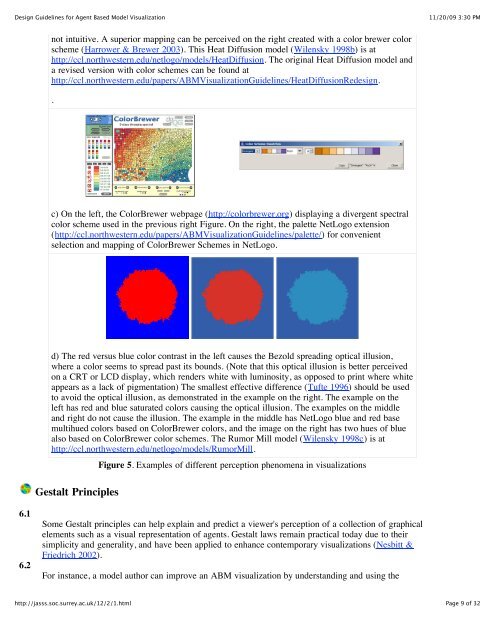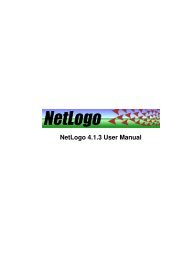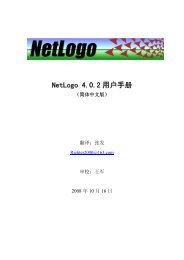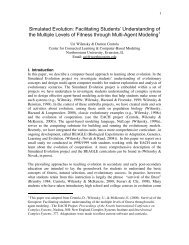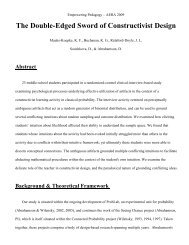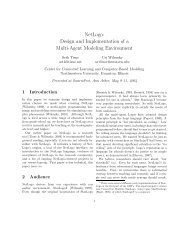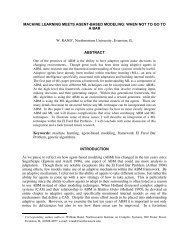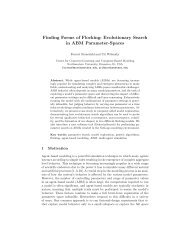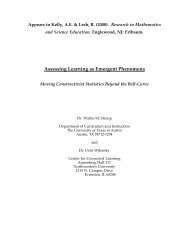Design Guidelines for Agent Based Model Visualization
Design Guidelines for Agent Based Model Visualization
Design Guidelines for Agent Based Model Visualization
You also want an ePaper? Increase the reach of your titles
YUMPU automatically turns print PDFs into web optimized ePapers that Google loves.
<strong>Design</strong> <strong>Guidelines</strong> <strong>for</strong> <strong>Agent</strong> <strong>Based</strong> <strong>Model</strong> <strong>Visualization</strong><br />
6.1<br />
6.2<br />
not intuitive. A superior mapping can be perceived on the right created with a color brewer color<br />
scheme (Harrower & Brewer 2003). This Heat Diffusion model (Wilensky 1998b) is at<br />
http://ccl.northwestern.edu/netlogo/models/HeatDiffusion. The original Heat Diffusion model and<br />
a revised version with color schemes can be found at<br />
http://ccl.northwestern.edu/papers/ABM<strong>Visualization</strong><strong>Guidelines</strong>/HeatDiffusionRedesign.<br />
.<br />
c) On the left, the ColorBrewer webpage (http://colorbrewer.org) displaying a divergent spectral<br />
color scheme used in the previous right Figure. On the right, the palette NetLogo extension<br />
(http://ccl.northwestern.edu/papers/ABM<strong>Visualization</strong><strong>Guidelines</strong>/palette/) <strong>for</strong> convenient<br />
selection and mapping of ColorBrewer Schemes in NetLogo.<br />
d) The red versus blue color contrast in the left causes the Bezold spreading optical illusion,<br />
where a color seems to spread past its bounds. (Note that this optical illusion is better perceived<br />
on a CRT or LCD display, which renders white with luminosity, as opposed to print where white<br />
appears as a lack of pigmentation) The smallest effective difference (Tufte 1996) should be used<br />
to avoid the optical illusion, as demonstrated in the example on the right. The example on the<br />
left has red and blue saturated colors causing the optical illusion. The examples on the middle<br />
and right do not cause the illusion. The example in the middle has NetLogo blue and red base<br />
multihued colors based on ColorBrewer colors, and the image on the right has two hues of blue<br />
also based on ColorBrewer color schemes. The Rumor Mill model (Wilensky 1998c) is at<br />
http://ccl.northwestern.edu/netlogo/models/RumorMill.<br />
Gestalt Principles<br />
http://jasss.soc.surrey.ac.uk/12/2/1.html<br />
Figure 5. Examples of different perception phenomena in visualizations<br />
Some Gestalt principles can help explain and predict a viewer's perception of a collection of graphical<br />
elements such as a visual representation of agents. Gestalt laws remain practical today due to their<br />
simplicity and generality, and have been applied to enhance contemporary visualizations (Nesbitt &<br />
Friedrich 2002).<br />
For instance, a model author can improve an ABM visualization by understanding and using the<br />
11/20/09 3:30 PM<br />
Page 9 of 32


